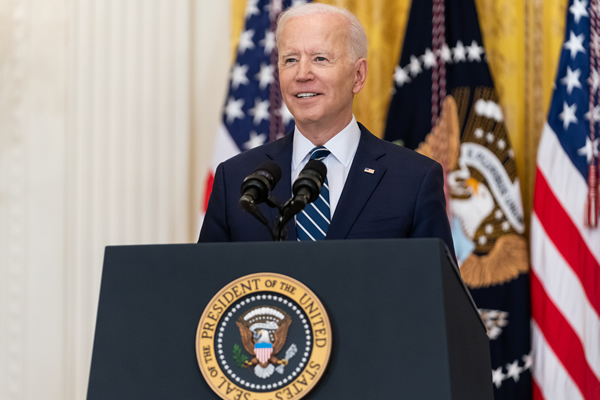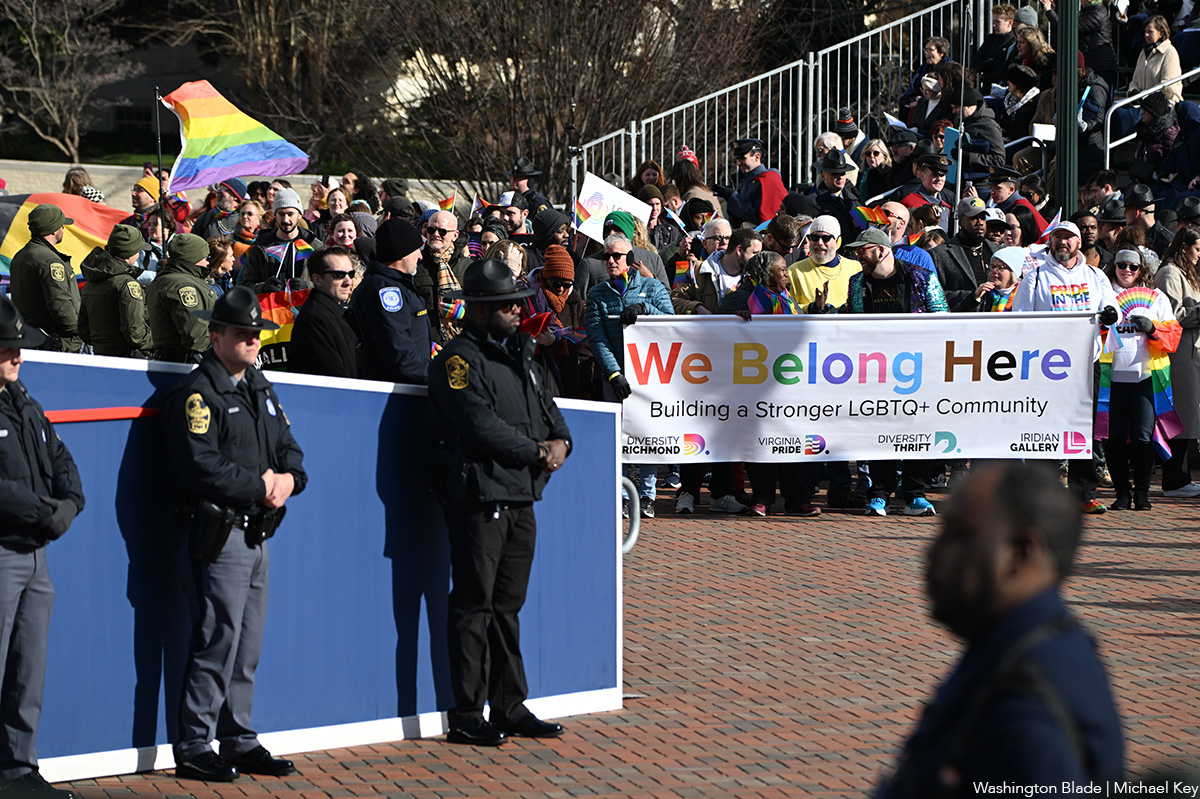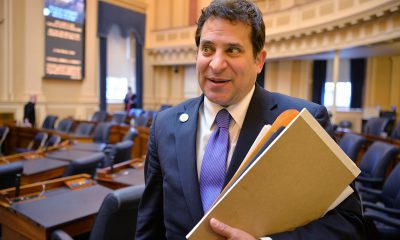News
Biden seeks to ramp up money to beat HIV/AIDS in budget request
$267 million increase sought to end domestic epidemic

President Biden’s formal budget proposal for the U.S. government in the upcoming fiscal year has advocates in the fight against HIV/AIDS cheering over the commitment to increase funds to confront the domestic epidemic, although one group is criticizing the proposal for seeking to flat-fund international programs.
The fiscal year 2022 proposal, unveiled last Friday, would afford an additional $246 million for domestic HIV testing, prevention and treatment programs for the Ending the HIV Epidemic initiative, which seeks to end HIV by 2030, and would also provide a general boost of $46 million to Ryan White HIV/AIDS programs and $20 million for HUD’s Housing Opportunities for People with AIDS (HOPWA).
Carl Schmid, executive director of the HIV + Hepatitis Policy Institute, said in a statement Biden is “demonstrating his commitment to ending HIV in the United States” in the budget request to Congress.
“While it falls short of what is needed and the community has requested, if this funding is realized it will continue the momentum already created and make further progress in ending HIV in the U.S. Efforts to end HIV will help eradicate an infectious disease that we have been battling for the last 40 years and help correct racial and health inequities in our nation,” Schmid said.
The total $670 million requested by the White House for the Ending the HIV Epidemic initiative breaks down as follows:
- Centers for Disease Control & Prevention: $100 million in new money for a total of $275 million;
- Ryan White: $85 million in new money for a total of $190 million;
- Community Health Centers for PrEP: $50 million in new money for a total of $152 million;
- National Institues of Health: $10 million in new money for a total of $26 million;
- Indian Health Services: $22 million in new money for a total of $27 million.
Counterinituitively, each of those numbers is actually below what the Trump White House proposed in the previous administration’s final budget request, with the exception of the proposed increase in money for Community Health Centers for PrEP and flat-lining for money for Indian Health Services.
The requested increase in funds for the Ending the HIV Epidemic was expected. Biden had signaled he’d seek the additional $267 million in funding in the “skinny budget” issued by the White House in February that preceded the more formal and detailed request to Congress last week.
Biden requests the increase in funds after he campaigned on ending the domestic HIV epidemic by 2025, an ambitious goal many advocates in the fight against HIV/AIDS were skeptical about achieving.
Nick Armstrong, the AIDS Institute’s manager of advocacy and government affairs and co-chair of the AIDS Budget & Appropriations Coalition, said in a statement the time to ramp up efforts against HIV has come as the nation emerges from the coronavirus pandemic.
“Public health departments have made herculean efforts to battle COVID over the past year,” Armstrong said. “But now it is time to reinvigorate neglected efforts to end the HIV, opioid, and viral hepatitis epidemics. Congress must go above and beyond what the president has proposed to bolster our critical public health infrastructure to protect Americans against infectious disease.”
The budget now goes on to Congress, which has authority on whether or not to appropriate funds consistent with the president’s request. Congress could either meet, short fund or even exceed in money the request by Biden as part of that process.
Schmid said via email to the Blade he’s optimistic about getting an agreement from Congress for an increase in funds to fight HIV/AIDS based on the “strong bipartisan support the proposal has enjoyed in the past.
“We still have work to do with the Congress due to so many demands on the budget but I am fairly confident Congress will support it, they have been anxious to see what the Biden administration does with the program in his budget and we have the answers now,” Schmid said. “The Biden-Harris administration firmly supports ending HIV.”
Although Biden was lauded for the increase in funds in domestic HIV programs, international programs are a different matter. The White House has essentially flat-funded programs designed to fight the global HIV epidemic, including the President’s Emergency Plan for AIDS Relief, or PEPFAR, or the Global Fund to Fight AIDS, Tuberculosis & Malaria.
Matthew Rose, director of U.S. Policy and Advocacy at the New York-based Health GAP, said in a statement Biden’s budget proposal “displays a lack of bold leadership motivated to end the HIV pandemic.”
“If the U.S. had continued fully funding PEPFAR since 2003 instead of letting funding levels slip into a flat-line for more than a decade, the HIV pandemic would look remarkably different today,” Rose said. “This is not a budget to end AIDS – and it could have been. This is not a budget to end the COVID-19 pandemic – and it could have been. The unconscionable lack of political will in recent years has created a world in which people cannot get access to the life-saving services they need.”
Health GAP is calling on Congress to approve a budget with at least a $750 million increase for PEPFAR and $2.5 billion in increased funding over the next four years to scale up HIV prevention and treatment and mitigate harms to the HIV response done by the COVID-19 pandemic, the statement says.
Additionally, Health GAP is calling on Biden to name “a highly qualified nominee” to serve as the U.S. Global AIDS Coordinator, the statement says.

Abigail Spanberger was sworn in as the 75th governor of Virginia at a ceremony on the grounds of the Virginia State Capitol on Saturday. Thousands of spectators watched the swearing-in ceremony and parade, despite the rain and temperatures in the low 40s.
Spanberger, a member of the Democratic Party and an LGBTQ ally, became the first woman to be Virginia’s governor.
View on Threads
Newly-elected Attorney General Jay Jones, Lt. Gov. Ghazala Hashmi, and Spanberger were each administered the oath of office in the public ceremony.

Republican former Gov. Glenn Youngkin left the ceremony shortly after the oath of office was administered to Spanberger and before the inaugural address.
In her speech, the new governor made an appeal to bipartisanship and looking past division in our current moment.
“To my friends in the General Assembly — on both sides of the aisle — I look forward to working with you,” said Spanberger. “I know what it means to represent your constituents, to work hard for your district, and to pursue policies you believe in. We will not agree on everything, but I speak from personal experience when I say that we do not have to see eye-to-eye on every issue in order to stand shoulder-to-shoulder on others.”
Spanberger acknowledged Virginians’ frustrations with federal layoffs and governmental policy.
“I know many of you are worried about the recklessness coming out of Washington. You are worried about policies that are hurting our communities — cutting healthcare access, imperiling rural hospitals, and driving up costs,” said Spanberger. “You are worried about Washington policies that are closing off markets, hurting innovation and private industry, and attacking those who have devoted their lives to public service.”
Spanberger alluded to the Trump-Vance administration, though never mentioned President Donald Trump’s name in her remarks.
Spanberger said, “you are worried about an administration that is gilding buildings while schools crumble, breaking the social safety net, and sowing fear across our communities, betraying the values of who we are as Americans, the very values we celebrate here on these steps.”
The new governor then spoke of her priorities in office, pledging to tackle housing affordability by working to “cut red tape” and increase housing supply. Spanberger also spoke of forestalling an impending healthcare crisis by protecting access and cracking down on “middlemen who are driving up drug prices.”
Spanberger spoke of investments in education at every level, standing up for workers (including the large number of federal workers in Virginia), and taking action on gun violence.
Virginia married couple Mary Townley and Carol Schall witnessed the inauguration ceremony from the stands set up on the grounds of the Capitol. Schall and Townley are one of the plaintiff couples in the case that challenged the Virginia constitutional ban on same-sex marriage.
Same-sex marriage became legal in Virginia in 2014.
“We are delighted with the inauguration of Abigail Spanberger as governor of Virginia,” Schall told the Washington Blade. “The celebration of her inauguration was full of the beautiful diversity that is Virginia. The Virginia Pride contingent was included as a part of what makes Virginia a great place to live.”
“Such an honor to attend such a wonderful event in Virginia history,” Townley told the Blade. “The weather before the Inauguration was cold and rainy, but I believe it represented the end of a dreary time and it ushered in the dry and sunny weather by the end of the inaugural parade. Madam Governor brought us to the light!”
The inaugural parade following the governor’s remarks included a contingent from Diversity Richmond and Virginia Pride. Marchers in the LGBTQ contingent carried a giant Progress Pride flag and were met with loud cheers from the gathered spectators.

Spanberger after her inauguration signed 10 executive orders. One of them bans discrimination against state employees based on sexual orientation, gender identity, and other factors.
“By virtue of the authority vested in me as Governor under Article V of the Constitution of
Virginia, I hereby declare that it is the firm and unwavering policy of the Commonwealth of Virginia to ensure equal opportunity in all facets of state government,” reads the executive order. “The foundational tenet of this executive order is premised upon a steadfast commitment to foster a culture of inclusion, diversity, and mutual respect for all Virginians.”
Virginia
VIDEO: LGBTQ groups march in Va. inaugural parade
Abigail Spanberger took office on Saturday

The inaugural ceremonies for Virginia Gov. Abigail Spanberger were held in Richmond, Va. on Saturday. Among the groups marching in the parade were Diversity Richmond and the Virginia Pride project of Diversity Richmond.
View on Threads

Virginia
Va. Senate approves referendum to repeal marriage amendment
Outgoing state Sen. Adam Ebbin introduced SJ3

The Virginia Senate on Friday by a 26-13 vote margin approved a resolution that seeks to repeal a state constitutional amendment that defines marriage as between a man and a woman.
Outgoing state Sen. Adam Ebbin (D-Alexandria) introduced SJ3. The Senate Privileges and Elections Committee on Wednesday approved it by a 10-4 vote margin.
Same-sex couples have been able to legally marry in Virginia since 2014. Outgoing Republican Gov. Glenn Youngkin in 2024 signed a bill that codified marriage equality in state law.
A resolution that seeks to repeal the Marshall-Newman Amendment passed in the General Assembly in 2021. The resolution passed again in 2025.
Two successive legislatures must approve the resolution before it can go to the ballot. Democrats in the Virginia House of Delegates have said the resolution’s passage is among their 2026 legislative priorities.
“It’s time for Virginia’s Constitution to reflect the law of the land and the values of today,” said Ebbin after Friday’s vote. “This amendment, if approved by voters, would affirm the dignity of all committed couples and protects marriage equality for future generations.”
-

 Iran4 days ago
Iran4 days agoGrenell: ‘Real hope’ for gay rights in Iran as result of nationwide protests
-

 Congress5 days ago
Congress5 days agoVan Hollen speaks at ‘ICE Out for Good’ protest in D.C.
-

 LGBTQ Non-Profit Organizations5 days ago
LGBTQ Non-Profit Organizations5 days agoNational LGBTQ Task Force brings Creating Change conference back to D.C.
-

 Virginia4 days ago
Virginia4 days agoMark Levine loses race to succeed Adam Ebbin in ‘firehouse’ Democratic primary














